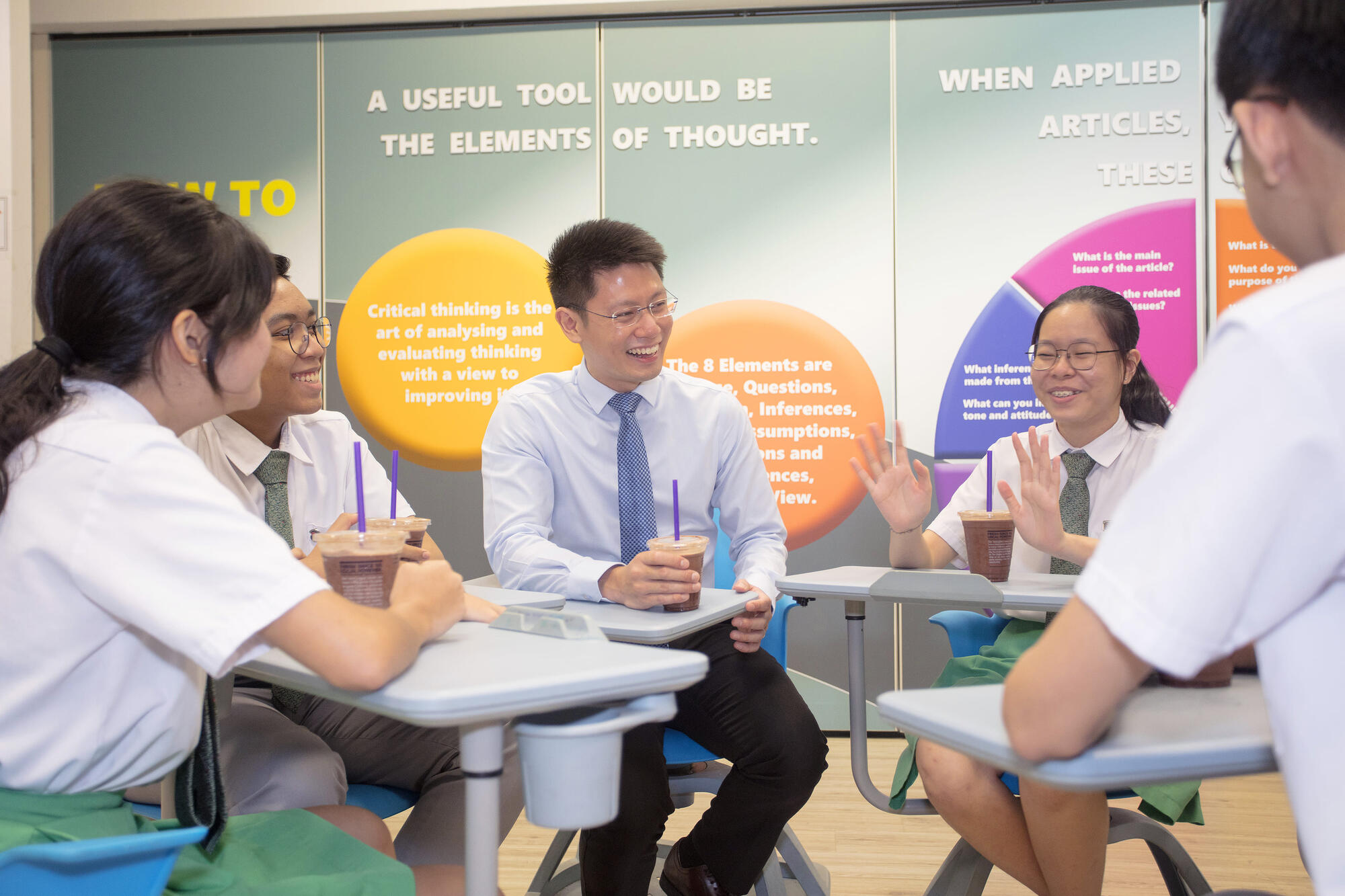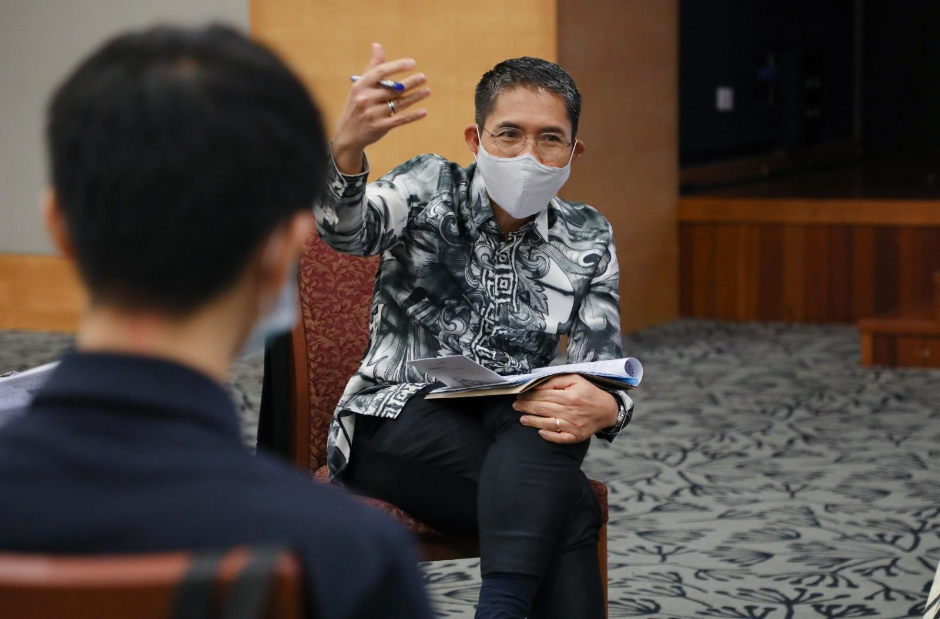Mr Chong Wensheng, Ahmad Ibrahim Secondary School, Outstanding Youth in Education Award 2022 Finalist
Tell us a story that captures the kind of teacher you are.
As a Form teacher, I see my class as a miniature replica of the larger society, where we have to find our own ways of interacting and living harmoniously alongside different kinds of people.
I believe what psychologist Thomas Lickona said, “One of the greatest moral questions that our society is faced with is – ‘How can we live with each other?’”
As young adults trying to find their ‘place’ in society, some tensions are inevitable among students. But I strongly believe that there needs to be a balance between asserting one’s individuality and respecting others.
One of my students, Emma*, was viewed by her classmates as an “irritating girl” who always spoke without thinking of others’ feelings. She would say things like, “Lisa* sucks at writing because she sucks at reading.” Her abrasive personality would turn every lesson into a war zone with name-calling the norm.
I realised that tensions among classmates were simmering beyond boiling point and organised Circle Time between Emma and a few of her most vocal opponents. I am a firm believer in the power of honest conversations, and Circle Time is a tool I use to get students talking about issues that are causing friction among them.
It’s always difficult to get the conversation going, but once students realise that they are in for the long haul and they can’t run away from this, they will talk openly and honestly.
“It’s always difficult to get the conversation going, but once students realise that they are in for the long haul and they can’t run away from this, they will talk openly and honestly.”
Mr Chong Wensheng
During this conversation, I ask them to say one positive thing about each other. This is the hardest part and breakthrough takes a long time. But I want them to try to see the other person in a different perspective. After much prompting, they said, “Emma is good in her studies.” Another student said, “She did not fall asleep in class.” It was a start.
Then I get them to share their dislikes about each other. This is the easy part but can easily spiral out of control as the students have tons of things to say. My role as facilitator is to get them to think about how their comments make the other person feel.
This segment requires repeated conversations, and results cannot be achieved in a day.
I believe that the decision to empathise with others is a conscious choice. And the decision to admit to one’s mistake – which is the first step in this process – is the hardest.
For Circle Time to succeed, I need to follow up with many one-to-one sessions with the students to hear their opinions. I try to get them to see the situation from different perspectives. For instance, in this case, I asked, “Do you really think that of Emma?” To Emma, I asked, “Did your classmates really say that about you? What is the evidence?” and lastly “How would you want them to approach you?”
Daily conversations like this coupled with weekly Circle Time brings breakthrough moments. In Emma’s case, she was not the first to admit her mistakes. At the fifth Circle Time, one of the girls admitted to spreading rumours about Emma. Mollified, Emma admitted that she had been wrong in putting up negative posts about her classmates.

Mr Chong believes in the power of honest conversations via Circle Time.
This was a huge moment for the group as Emma had, for years, never admitted that she could be in the wrong. She had lost friends, undergone counselling and even absented herself from school, but she had never admitted any mistake on her part.
A cloud seemed to have lifted.
I knew that the needle had shifted when one of the classmates, said, “Can you help us learn History better, since your notes are very organised?”
And from Emma, a simple phrase that made me very happy: “Next time you all get OCM (Oreo Chocolate Milkshake from a popular shop nearby), get one for me also ok.”
The happy ending to this story is that Emma did slowly develop friendships. At her graduation ceremony, Emma was not left out, and was seen hugging and taking pictures with her peers, whom she had once seen as ‘enemies’. Many would argue that this is a common sight at graduation. However, for Emma’s case and her peers involved, this was a powerful image that showed that they had overcome their differences and learned to live and appreciate each other’s strengths and shortcomings.
Describe a teaching method or tool you have found effective.
As Character and Citizenship Education Coordinator for National Education, one of the issues I try to tackle is the ‘If it doesn’t concern me, why should I care about it,’ attitude. “So boring, Mr Chong,” say my students as I talk about, say, race issues or National Service.
In the spirit of honest conversations that I am a great advocate for, and to get my students to understand why these issues do matter, I bring in experts, who can answer my students’ questions.
So, we had a speaker from the Singapore Armed Forces talking about cyber security threats. When engaged, students show how much they do actually know about what’s going on by asking questions, like ‘Do you think online access has changed how Singaporeans think about the safety of the country?
We also had the National Arts Council put up a skit on prejudice and discrimination, which was followed by Q&A. I was so pleased when one of my students commented, “We think that our jokes are funny and harmless, but we never step into others’ shoes to think how they feel.” I want to open my students’ mind to different issues, and I use the Clarify/Sensitise/Influence (CSI) tool to carry out these conversations.
For instance, on the topic of race, I ask about their thoughts on racial diversity in Singapore or how they define casual racism. The purpose of clarifying is to get students to look into their own personal beliefs and experiences.
To ‘sensitise’, we talk about the experience of race in other countries and whether and how they differ from Singapore. Next is to get students to come to their own conclusions guided by questions and the societal norms and implications of their choice.
My class is racially diverse, so we have rich conversations about mindsets and preconceived notions about race. For every negative comment, there are positive voices and new perspectives. Every student has a voice and an opportunity to be heard.
However, these are pervasive societal issues that cannot be rectified overnight. Providing students with a platform to discuss it openly in class, without fear or repercussions, is a step in the right direction, I believe.
The outcomes cannot be seen through one lesson. It is through repeated reminders and awareness building that behaviours and attitudes shift.
I have used a similar approach to talk about various issues, like how Singapore plans its budget, or current affairs, like the war in Ukraine. Students put themselves in the shoes of decision-makers to think through the choices they need to make and why.
It’s always difficult to get the conversation going, but once students realise that they are in for the long haul and they can’t run away from this, they will talk openly and honestly.
“Seeing the positive change in my students, I am reminded of my purpose as an educator and not just a teacher who delivers content.”
These are not sure-fire ways to create active citizenship. But if we can get them talking about issues, seeing different perspectives and arguments, that will be good enough for me for now.
Starting these discussions are a challenge as a teacher, but I feel my effort is worth it every time a student goes beyond individualistic phrases starting with ‘I’ to a response that begins with ‘We’. This shows me that they are able to care beyond their own needs and interests.
Which school project or initiative are you especially proud of
What comes before a student takes a genuine interest in national issues? A teacher, who is comfortable in facilitating these conversations.
To be honest, it is challenging for teachers, too, as they need to move out of their comfort zone to navigate different mindsets and perspectives. There is also a lot of background reading and understanding that they need to do to keep up to date on various issues that are constantly evolving.
As (Internal) CCE Subject Head, I work closely with my team of four Specialised CCE teachers (SCTs) to empower and inspire every teacher to engage students effectively on these issues.
To help them, I started putting together a baseline resource – CCE Bytes. These are bite-sized information on current affairs with reflective questions, FAQs and tips to ease teachers into these conversations on what could be sensitive issues.
One example would be the discussion on race, following Minister Lawrence Wong’s speech at the IPS-RSIS forum in 2021, or the Russia-Ukraine crisis this year. These CCE Bytes act as a professional development package for the teachers – a starter kit that they can then build on.
To build up the confidence of teachers, I have also been organising CCE engagement sessions for the last two years with my team of SCTs to discuss the CCE2021 curriculum in depth.
During these sessions, we role-play different facilitation strategies, we discuss possible responses from students and brainstorm approaches to help students understand the issues better.
After initial challenges, I am proud to say that peers and colleagues now approach me with new strategies and discussions on effective pedagogical tips and stories.
One idea was to use the mentimeter platform to get students to realise the common discriminatory phrases used against other races. In classes that are more vocal, teachers use the ‘hot seat’ method to get students from minority groups to share their experiences and thoughts on how they have been treated.
There have also been collaborations between the Year Head Team and the CCE committee to carry out weekly morning messages on, say, the dangers of posting discriminatory remarks on social media platforms, or cyberbullying incidents.
Others ideas have turned into VIA (Values-in-action) class activities. One of the lower secondary classes became advocates against racial and religious discrimination. They put out posters and went to different classes to share about the challenges and the ‘correct’ approaches to use when encountering friends who may speak or act in a discriminatory manner.
These are just some ways in which our discussions of these topics have evolved beyond CCE lessons.
Seeing the positive change in my students, I am reminded of my purpose as an educator and not just a teacher who delivers content. Our role is to address and fulfil learning needs.
But like students, we teachers must also be cognisant of our shortcomings by recognising our learning gaps. Just as I believe that it is important for students to be engaged in these timely discussions, we teachers must be the first to role model these reflections by showing interest, concern and an awareness for societal issues beyond our classrooms.
 Engaging students in timely discussions of societal issues.
Engaging students in timely discussions of societal issues.




584663a7a8a66eb2afccc900c73e6f2e.jpg)

